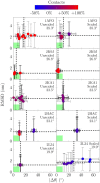Excessive aggregation of membrane proteins in the Martini model
- PMID: 29131844
- PMCID: PMC5683612
- DOI: 10.1371/journal.pone.0187936
Excessive aggregation of membrane proteins in the Martini model
Abstract
The coarse-grained Martini model is employed extensively to study membrane protein oligomerization. While this approach is exceptionally promising given its computational efficiency, it is alarming that a significant fraction of these studies demonstrate unrealistic protein clusters, whose formation is essentially an irreversible process. This suggests that the protein-protein interactions are exaggerated in the Martini model. If this held true, then it would limit the applicability of Martini to study multi-protein complexes, as the rapidly clustering proteins would not be able to properly sample the correct dimerization conformations. In this work we first demonstrate the excessive protein aggregation by comparing the dimerization free energies of helical transmembrane peptides obtained with the Martini model to those determined from FRET experiments. Second, we show that the predictions provided by the Martini model for the structures of transmembrane domain dimers are in poor agreement with the corresponding structures resolved using NMR. Next, we demonstrate that the first issue can be overcome by slightly scaling down the Martini protein-protein interactions in a manner, which does not interfere with the other Martini interaction parameters. By preventing excessive, irreversible, and non-selective aggregation of membrane proteins, this approach renders the consideration of lateral dynamics and protein-lipid interactions in crowded membranes by the Martini model more realistic. However, this adjusted model does not lead to an improvement in the predicted dimer structures. This implicates that the poor agreement between the Martini model and NMR structures cannot be cured by simply uniformly reducing the interactions between all protein beads. Instead, a careful amino-acid specific adjustment of the protein-protein interactions is likely required.
Conflict of interest statement
Figures




Similar articles
-
Addressing the Excessive Aggregation of Membrane Proteins in the MARTINI Model.J Chem Theory Comput. 2021 Apr 13;17(4):2513-2521. doi: 10.1021/acs.jctc.0c01253. Epub 2021 Mar 15. J Chem Theory Comput. 2021. PMID: 33720709 Free PMC article.
-
Evaluating the Efficiency of the Martini Force Field to Study Protein Dimerization in Aqueous and Membrane Environments.J Chem Theory Comput. 2021 May 11;17(5):3088-3102. doi: 10.1021/acs.jctc.0c00507. Epub 2021 Apr 29. J Chem Theory Comput. 2021. PMID: 33913726
-
NMR-based approach to measure the free energy of transmembrane helix-helix interactions.Biochim Biophys Acta. 2014 Jan;1838(1 Pt B):164-72. doi: 10.1016/j.bbamem.2013.08.021. Epub 2013 Sep 10. Biochim Biophys Acta. 2014. PMID: 24036227
-
Towards design of drugs and delivery systems with the Martini coarse-grained model.QRB Discov. 2022 Oct 12;3:e19. doi: 10.1017/qrd.2022.16. eCollection 2022. QRB Discov. 2022. PMID: 37529288 Free PMC article. Review.
-
Perspective on the Martini model.Chem Soc Rev. 2013 Aug 21;42(16):6801-22. doi: 10.1039/c3cs60093a. Chem Soc Rev. 2013. PMID: 23708257 Review.
Cited by
-
Lipid Organization by the Caveolin-1 Complex.bioRxiv [Preprint]. 2024 Jul 13:2024.07.10.602986. doi: 10.1101/2024.07.10.602986. bioRxiv. 2024. Update in: Biophys J. 2024 Nov 5;123(21):3688-3697. doi: 10.1016/j.bpj.2024.09.018. PMID: 39026816 Free PMC article. Updated. Preprint.
-
Optimizing Gō-MARTINI Coarse-Grained Model for F-BAR Protein on Lipid Membrane.Front Mol Biosci. 2021 Feb 22;8:619381. doi: 10.3389/fmolb.2021.619381. eCollection 2021. Front Mol Biosci. 2021. PMID: 33693028 Free PMC article.
-
Effective Molecular Dynamics from Neural Network-Based Structure Prediction Models.J Chem Theory Comput. 2023 Apr 11;19(7):1965-1975. doi: 10.1021/acs.jctc.2c01027. Epub 2023 Mar 24. J Chem Theory Comput. 2023. PMID: 36961997 Free PMC article.
-
Protein dynamics and lipid affinity of monomeric, zeaxanthin-binding LHCII in thylakoid membranes.Biophys J. 2022 Feb 1;121(3):396-409. doi: 10.1016/j.bpj.2021.12.039. Epub 2021 Dec 28. Biophys J. 2022. PMID: 34971616 Free PMC article.
-
Coarse Grained Molecular Dynamic Simulations for the Study of TNF Receptor Family Members' Transmembrane Organization.Front Cell Dev Biol. 2021 Jan 21;8:577278. doi: 10.3389/fcell.2020.577278. eCollection 2020. Front Cell Dev Biol. 2021. PMID: 33553138 Free PMC article.
References
-
- Ferré S, Casadó V, Devi LA, Filizola M, Jockers R, Lohse MJ, et al. G Protein–Coupled Receptor Oligomerization Revisited: Functional and Pharmacological Perspectives. Pharmacol Rev. 2014;66(2):413–434. doi: 10.1124/pr.113.008052 - DOI - PMC - PubMed
-
- Gomes I, Ayoub MA, Fujita W, Jaeger WC, Pfleger KD, Devi LA. G Protein-Coupled Receptor Heteromers. Annu Rev Pharmacol Toxicol. 2016;56:403–425. doi: 10.1146/annurev-pharmtox-011613-135952 - DOI - PMC - PubMed
-
- Haass C, Selkoe DJ. Soluble Protein Oligomers in Neurodegeneration: Lessons From the Alzheimer’s Amyloid β-Peptide. Nat Rev Mol Cell Biol. 2007;8(2):101–112. doi: 10.1038/nrm2101 - DOI - PubMed
-
- Ghosh A, Sonavane U, Joshi R. Multiscale Modelling to Understand the Self-Assembly Mechanism of Human β2-Adrenergic Receptor in Lipid Bilayer. Computat Biol Chem. 2014;48:29–39. doi: 10.1016/j.compbiolchem.2013.11.002 - DOI - PubMed
-
- Mondal S, Johnston JM, Wang H, Khelashvili G, Filizola M, Weinstein H. Membrane Driven Spatial Organization of GPCRs. Sci Rep. 2013;3:2909 doi: 10.1038/srep02909 - DOI - PMC - PubMed
MeSH terms
Substances
LinkOut - more resources
Full Text Sources
Other Literature Sources

